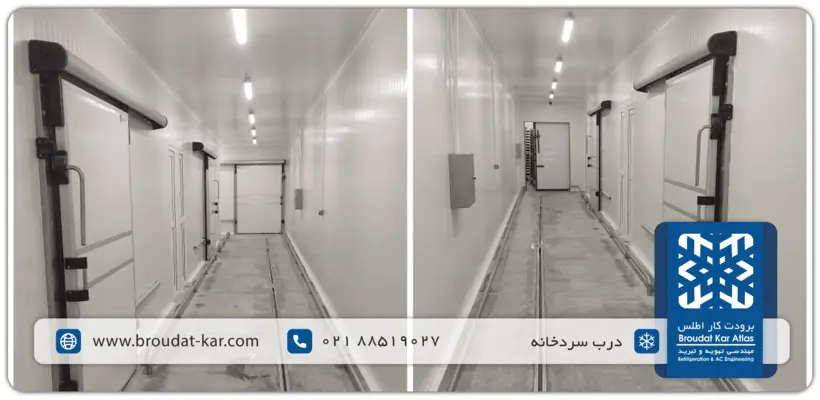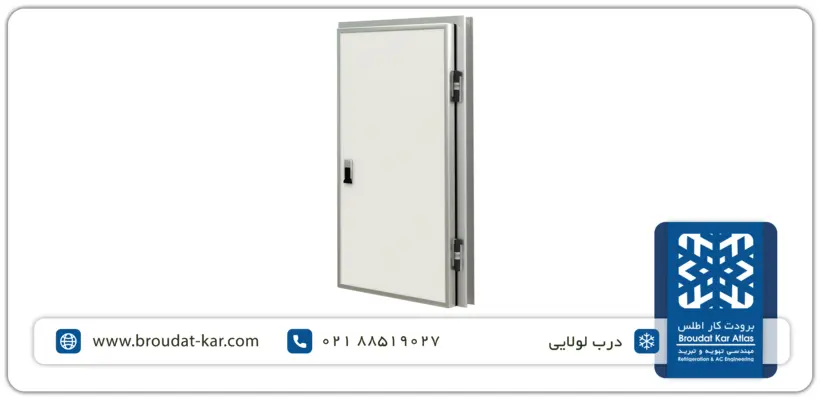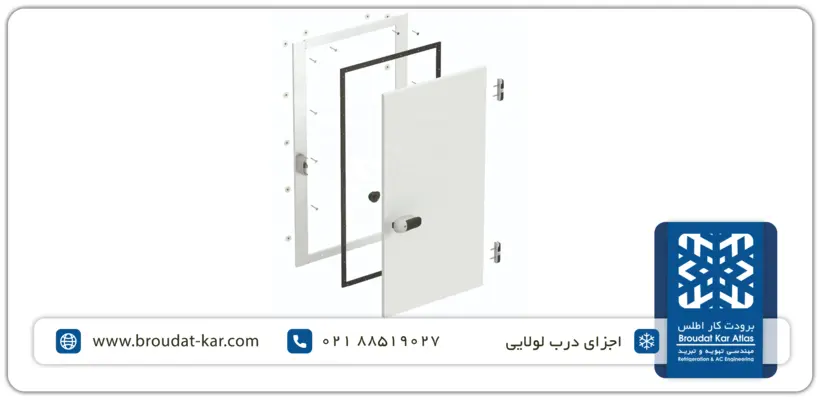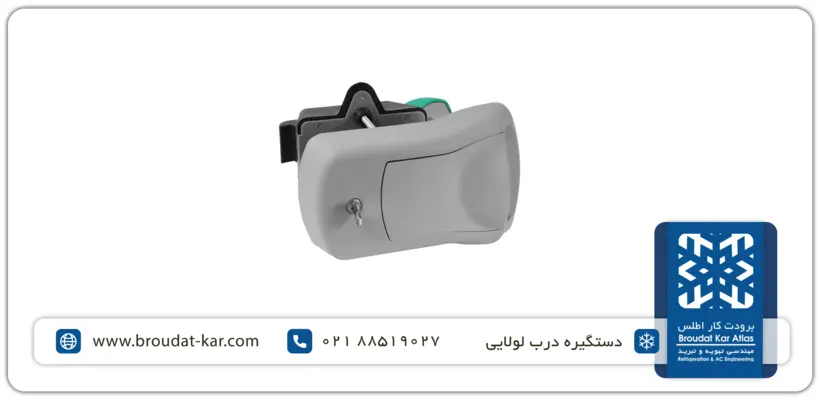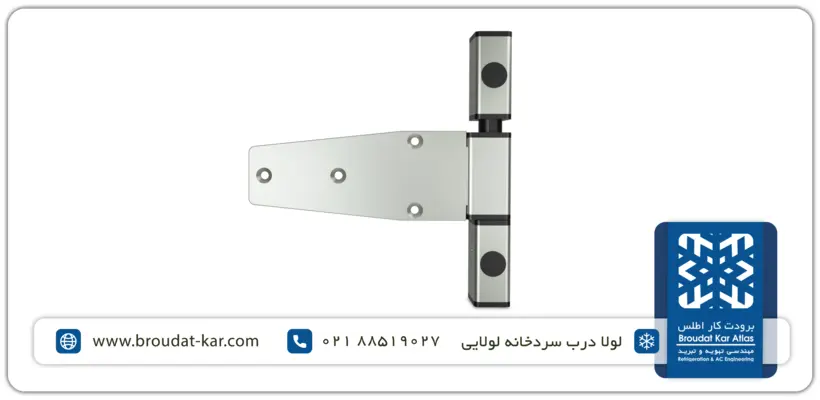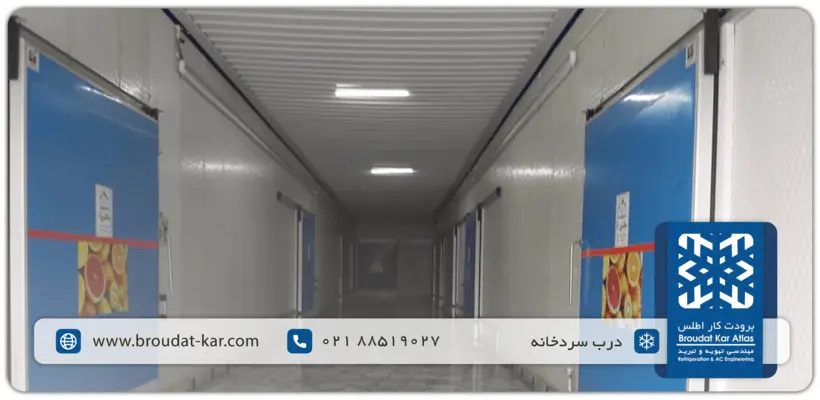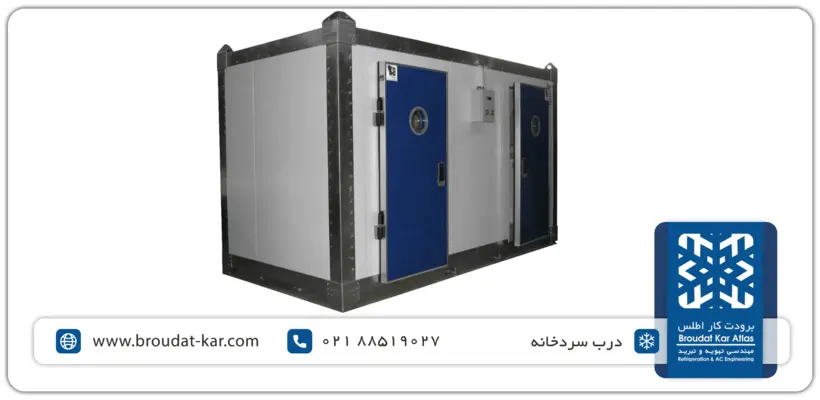Cold Storage Door
The cold storage door is a crucial element of any temperature-controlled facility, acting as the main barrier against heat infiltration. Its primary function is to maintain the thermal integrity of the storage area, ensuring that the desired temperature is consistently achieved and preserved, regardless of external conditions. Cold storage doors are essential across a range of industries, including food and pharmaceutical storage, laboratories, and catering services, where precise temperature regulation is key to preserving product quality and safety.
Industrial cold storage doors come in a variety of designs to meet specific requirements, such as above-zero doors for areas with temperatures above freezing and heavily insulated doors for below-zero applications. These doors are engineered to minimize temperature variations, which reduces energy consumption, enhances operational efficiency, and safeguards stored products against spoilage or damage. Selecting the appropriate cold storage door is key to maintaining optimal storage conditions, boosting overall facility performance, and achieving substantial energy savings over time.
Key Features of Cold Storage Doors
Cold storage doors are crafted with advanced features that ensure reliable performance, energy efficiency, and easy access, making them essential for any temperature-controlled environment.
- High-Performance Insulation:
Cold storage doors use high-density insulation materials like polyurethane or polystyrene, chosen for their excellent thermal resistance (high R-values). These materials act as effective barriers, minimizing heat transfer and helping maintain a stable internal temperature, which reduces energy costs and preserves the quality of stored products.
- Robust Construction and Durability:
Designed to withstand heavy use and challenging conditions such as high humidity and temperature fluctuations, cold storage doors are built from strong, corrosion-resistant materials like stainless steel or aluminum. This robust construction enhances the door’s lifespan, stability, and resilience, even in harsh environments.
- Advanced Sealing Mechanisms:
Effective sealing is vital for maintaining temperature control. Gaskets and perimeter strips made of rubber or silicone create an airtight seal when the door is closed, preventing air leakage and minimizing heat exchange. This feature plays a key role in maintaining energy efficiency and keeping the cold storage environment stable.
- Easy and Efficient Access Options:
Cold storage doors are designed for ease of use, with features like self-closing mechanisms and ergonomic handles that ensure smooth operation. In facilities with frequent traffic, sliding or automatic doors can be especially beneficial, offering quick and convenient access without compromising temperature stability.
- Flexible Customization Options:
No two cold storage needs are the same, so customization is essential. Customers can choose the size, insulation thickness, and type of door to match their specific requirements. For instance, large industrial spaces may need wider doors, while pharmaceutical applications might require enhanced insulation. Atlas Refrigeration Co. offers tailored solutions to meet the unique demands of each project, ensuring optimal performance in every application.
Types of Cold Storage Doors
Cold storage doors come in various types, each tailored to meet specific requirements and storage conditions. Choosing the right door type is essential for maximizing efficiency, optimizing space, and ensuring ease of access, which are all critical for the reliable operation of any cold storage facility.
Hinged Cold Storage Doors
Hinged cold storage doors are typically used in smaller cold storage areas where frequent access is not required. These doors swing outward on hinges, offering a straightforward design that is easy to install. They are insulated with injected polyurethane for effective thermal resistance and are reinforced with strong hinges and secure locks to ensure an airtight seal when closed. Hinged doors are an excellent choice for compact spaces that have enough room for the door to open fully, such as small food storage cold rooms.
Sliding Cold Storage Doors
Sliding cold storage doors are ideal for larger facilities with high traffic, as they open horizontally along a track, saving space by eliminating the need for a swing area. This design provides unobstructed access, making it easier to move bulky items in and out. Sliding doors are available in both manual and electric models, and can be customized with automation features for hands-free operation, which is particularly beneficial in environments that require quick and frequent access. They are commonly used in industrial cold storage facilities and distribution centers where maximizing space and accessibility is essential.
Above-Zero Cold Storage Doors
Above-zero cold storage doors are designed for cold rooms that maintain temperatures above 0°C. These doors feature injected polyurethane insulation, typically ranging from 7 to 10 cm thick, ensuring efficient thermal performance. They are ideal for facilities storing perishable but non-frozen products, such as fresh produce, dairy items, and cut flowers. Above-zero cold storage doors help maintain a cool, stable environment, effectively meeting the requirements for moderate cooling needs while preserving the quality of stored goods.
Below-Zero Cold Storage Doors
Below-zero cold storage doors are specifically designed for environments that maintain sub-zero temperatures, ideal for freezing and long-term preservation applications. These doors are built with thick injected polyurethane insulation, typically between 12 to 15 cm, offering superior thermal resistance and minimizing frost buildup. To prevent the door and frame from freezing, heating elements are often integrated into the gaskets, ensuring a reliable, airtight seal even in extreme cold conditions.
Electric Cold Storage Doors
Electric cold storage doors utilize automated systems for seamless opening and closing, often controlled via sensors, remote access, or integrated control panels. These doors are particularly beneficial in high-traffic facilities, offering convenient, hands-free operation that eliminates the need for manual handling. By reducing the duration, the door remains open, the automated mechanism enhances energy efficiency, minimizing air exchange and temperature loss. Electric cold storage doors are widely used in large distribution centers and industrial facilities where maintaining a smooth, uninterrupted workflow is crucial.
Atmosphere-Controlled Cold Storage Doors
Atmosphere-controlled cold storage doors are designed to maintain a stable, precise environment by minimizing gas exchange and air leakage. Equipped with advanced sealing systems and reinforced insulation, these doors are ideal for preserving specific gas concentrations and humidity levels, which are crucial for extending the shelf life of perishable goods like fruits and vegetables. Tailored to meet the stringent requirements of controlled atmosphere storage, these doors ensure optimal product preservation while enhancing energy efficiency.
Components of Cold Storage Doors
Cold storage doors are constructed from a variety of specialized components that enhance performance, durability, and insulation. Understanding these components is essential for recognizing how cold storage doors maintain temperature stability and ensure user-friendly access.
- Door Frame
The door frame provides a strong, precise opening, essential for creating an airtight seal around the door. Made from high-strength materials like stainless steel or aluminum, these frames are designed to withstand moisture and resist temperature fluctuations. A well-designed frame ensures proper alignment, preventing gaps that could lead to heat leakage. - Cold Storage Door Insulation
The core of cold storage doors contains dense insulating materials such as polyurethane or polystyrene, which minimize heat transfer. This insulation is vital for maintaining optimal internal temperatures and reducing energy costs. The thickness of the insulation varies depending on the required operating temperature: the colder the storage, the thicker the insulation. - Gaskets and Sealing Strips
Sealing strips, made of flexible materials, are placed around the edges of the door to prevent air leaks when the door is closed. These gaskets can be magnetic or pressure-based, effectively blocking warm air from entering the cold storage. Proper sealing is critical for energy efficiency and maintaining consistent internal temperatures, even with frequent door use. - Handles and Locks
Cold storage doors are equipped with durable industrial handles and locks for secure closure. Ergonomic handles ensure easy gripping, allowing quick access when needed. Emergency internal handles are included to allow users to exit from the inside, ensuring safety in case of entrapment.
- Hinges or Sliding Tracks
For hinged doors, industrial-grade hinges support the weight of the door and ensure smooth opening and closing. For sliding doors, a precisely engineered rail system allows the door to glide horizontally with minimal effort. These hinges and tracks are durable and wear-resistant, crucial for maintaining the structural integrity of the door over time.
- Perimeter Heating Element
In below-zero cold storage doors, heating elements are often integrated around the edges of the door to prevent ice formation. These heating elements keep door seals from freezing, ensuring smooth operation even in extremely low temperatures. The system is energy-efficient, activating only when the door’s temperature falls below a certain threshold. - Control System (For Electric Doors) Electric cold storage doors include automation components such as sensors and motorized systems for hands-free operation. Motion sensors or remote controls enable automatic opening and closing, improving accessibility and minimizing the entry of warm air. These automation systems are particularly beneficial in high-traffic areas where frequent access is needed.
Technical Specifications of Cold Storage Doors
Cold storage doors are meticulously designed and constructed to meet specific technical specifications that ensure energy efficiency, durability, and optimal temperature control. These specifications guide the selection process, ensuring that each door performs reliably in various cold storage environments.
- Insulation Thickness
Cold storage doors come with different insulation thicknesses to match the required internal temperature ranges. Insulation typically varies from 60 mm for above-zero applications to 150 mm or more for sub-zero environments. Thicker insulation provides greater thermal resistance, maintaining temperature stability even under extreme cold conditions.
- Thermal Conductivity (U-Value)
The U-value indicates the rate of heat transfer through the door. Cold storage doors are designed to have low U-values, generally below 0.3 W/m²K, which minimizes heat ingress. This specification is crucial for maintaining stable internal temperatures and reducing energy consumption, particularly in environments requiring precise temperature control.
- Air Permeability
Air permeability measures the extent of air leakage through closed doors. Cold storage doors are equipped with high-quality silicone strips and airtight sealing systems, achieving near-zero air permeability. This feature prevents warm air from entering, enhancing energy efficiency and maintaining consistent internal temperatures within the cold room.
- Moisture and Corrosion Resistance
Cold storage doors are exposed to high humidity, particularly in areas where doors are frequently opened and closed. To combat this, doors are constructed with corrosion-resistant materials such as stainless steel or anodized aluminum. These materials, along with corrosion-resistant coatings, prevent rust and degradation, ensuring long-lasting durability in humid environments.
- Compliance with Safety Standards
Cold storage doors are manufactured in compliance with industry safety standards, such as ISO 9001 or CE certifications. These standards guarantee that the door meets stringent criteria for quality, durability, and performance. Additionally, safety features, such as emergency exit handles, are often included to protect users in case of emergencies.
Applications of Cold Storage Doors
Cold storage doors are essential in industries that require the storage of perishable goods, pharmaceuticals, and temperature-sensitive materials. With their versatile design and durable construction, these doors ensure reliable performance across a wide range of environments.
Food Industry
Cold storage doors are vital for preserving the freshness of food products. They are commonly used in cold storage facilities, grocery stores, supermarkets, and large food processing centers to store meat, dairy, fruits, vegetables, and seafood. By providing an airtight seal, these doors help maintain quality and extend the shelf life of food products.
Pharmaceutical and Laboratory Industries
The pharmaceutical and laboratory industries rely heavily on cold storage solutions for vaccines, medications, and other biologically sensitive products. Cold storage doors in this sector are designed to maintain precise temperature control, ensuring the efficacy and stability of pharmaceutical products. Hospitals, research laboratories, and biotechnology companies use specialized cold storage doors to meet regulatory standards for safe storage.
General Applications
Cold storage doors are essential in any industry where temperature control is critical for product quality, safety, and regulatory compliance. Their versatility and robust design ensure they meet the diverse needs of various sectors, from food storage to pharmaceuticals and beyond.
Choosing the Right Cold Storage Door
Selecting the appropriate cold storage door depends on factors like temperature range, traffic volume, and specific application needs. For above-zero storage, doors with 7–10 cm of insulation thickness are adequate, while below-zero storage requires a minimum of 12–15 cm of insulation and heating elements to prevent door freezing.
When deciding on door operation—hinged or sliding—consider space and traffic flow. Hinged doors are ideal for smaller, low-traffic areas, while sliding or automatic doors are more suitable for larger, high-traffic environments. Door dimensions should accommodate equipment such as forklifts, pallet trucks, and the size of stored loads.
Material selection, such as stainless steel or aluminum, influences durability and moisture resistance. A high-quality sealing system with silicone gaskets is essential for minimizing energy loss.
Purchasing Cold Storage Doors from Atlas Refrigeration Company
When purchasing cold storage doors from Atlas, you will be guided through a thorough selection process tailored to your specific storage requirements. Begin by determining the desired storage temperature—whether for above-zero cold storage, below-zero storage, or freezing tunnels—since this will dictate the necessary insulation and sealing features.
Atlas Company Cold Storage Doors
Atlas offers a comprehensive selection of cold storage doors, including hinged, sliding, butterfly, and automatic options. We provide customizable sizes and insulation thicknesses to optimize performance based on your specific storage requirements. Durability is a key priority, which is why we use high-quality materials like stainless steel and anodized aluminum for long-lasting resistance to moisture and corrosion. With Atlas Refrigeration Co, you receive expert consultation, personalized solutions, and dependable after-sales support.
Pricing for Cold Storage Doors
The cost of cold storage doors depends on various factors, including the type of door, size, insulation thickness, material, and additional features such as automation, locks, or heating elements for below-zero applications. Hinged doors generally cost less and are suitable for smaller, low-traffic cold storage areas, while sliding and automatic doors, designed for larger facilities, are priced higher due to their advanced mechanisms and space-saving benefits.
Customization also impacts pricing. Doors tailored to specific dimensions or with advanced insulation for freezing conditions are priced higher. Opting for high-quality materials like stainless steel, galvanized steel, or aluminum increases the cost but offers greater durability and longevity, making it a worthwhile investment.
At Atlas Refrigeration Co., we offer competitive pricing tailored to your needs, ensuring you get the best value for your cold storage door without compromising on quality. For a precise quote tailored to your project, contact our team today. We are here to assist you in selecting the ideal cold storage door, provide detailed pricing, and offer expert guidance every step of the way.
Importance of Cold Storage Door Maintenance
Regular maintenance of cold storage doors is crucial to ensuring optimal performance, preventing energy loss, and extending the door’s lifespan. The first step is to regularly check the airtightness of the door, including gaskets and hinges. Over time, sealing strips may wear out or become damaged, leading to air leaks and higher energy costs. Replacing worn seals promptly helps maintain an airtight environment.
Hinges, rollers, and tracks (for sliding doors) should be lubricated regularly to ensure smooth operation and prevent mechanical wear. Unusual noises or resistance when opening and closing the door may indicate the need for adjustments or repairs.
Additionally, periodic cleaning of the door surfaces and frame helps prevent dirt buildup and frost accumulation. Frost can damage door seals and reduce efficiency, so it is important to ensure that heating elements (if present) are functioning properly to prevent freezing.
Regularly testing safety features, such as internal emergency release handles and automatic sensors, is essential for ensuring they work correctly. This is vital for user safety and compliance with industry standards.
Finally, scheduling professional inspections as part of your maintenance plan is recommended. -Kar Atlas offers routine service visits to assess the condition of your cold storage door, identify potential issues early, and perform necessary repairs or adjustments. Consistent maintenance maximizes energy efficiency, reduces downtime, and prolongs the life of your cold storage door.
Atlas Cold Storage Door Services
Atlas Company offers a comprehensive range of cold storage door services designed to meet the unique needs of industries such as food preservation, pharmaceuticals, and logistics. Our expert team provides consultation to guide you in selecting the right door—whether hinged, sliding, or automatic—based on your specific temperature requirements and operational needs.
We manage the entire process, from accurate measurements and custom fabrication to professional installation. Our cold storage doors are made from high-quality materials to ensure durability, optimal insulation, and outstanding energy efficiency.
After installation, we offer maintenance and servicing to prevent costly breakdowns and minimize energy loss. Atlas also supports the ordering, purchasing, and installation of cold storage doors in Tehran and other cities across Iran.
The best cold storage door for your facility depends on factors such as the temperature range, traffic flow, and available space. Hinged doors are ideal for small, low-traffic cold rooms, while sliding and automatic doors are better suited for larger, high-traffic areas. Atlas Company can assess your specific needs and recommend the most suitable door for your application.
Choosing the right dimensions for your cold storage door is crucial for ensuring optimal performance and energy efficiency. The door must fit the opening precisely to provide proper insulation. Additionally, consider equipment such as forklifts when determining the door size to accommodate smooth loading and unloading.
Yes, all cold storage doors are insulated to maintain internal temperatures and improve energy efficiency. Atlas Company offers insulated cold storage doors in various thicknesses and materials to meet different temperature requirements, including above-zero and below-zero applications.
To receive a customized price quote, simply contact us with details about your cold storage needs, including size, temperature range, and traffic flow. Our team will work with you to provide a tailored solution and competitive pricing.
Yes, Atlas Company provides complete installation services for cold storage doors. Our experts ensure proper installation, efficient operation, and compliance with safety and energy standards.
Related posts
Cold Storage Door
Portable Cold Store; Design and Construction of Portable Cold Store + Price The portable cold room, also known as
What Is Meat Cold Storage? Meat cold storage, also known as a meat refrigeration facility, is a specialized center dedicated
What is dairy cold storage? Dairy cold storage stands as a pivotal element within the dairy industry, crucial for the
What Is Chicken Cold Storage? Chicken cold storage refers to specialized equipment designed for preserving poultry products like chicken
Fish and Shrimp Cold Storage Systems – Preserving Freshness Fish and shrimp cold storage facilities play an important role in
What is Fruit Cold Storage? A Fruit cold storage is a specialized facility designed to store fruits and vegetables
